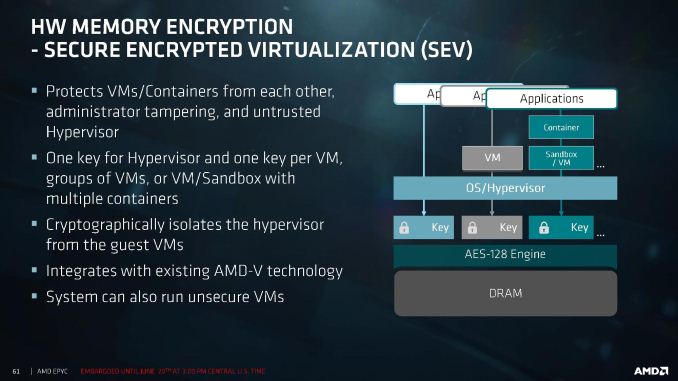AMD's Future in Servers: New 7000-Series CPUs Launched and EPYC Analysis
by Ian Cutress on June 20, 2017 4:00 PM EST- Posted in
- CPUs
- AMD
- Enterprise CPUs
- EPYC
- Whitehaven
- 1P
- 2P
With recent fears about security, and given that these processors are aiming to go to the Enterprise space, AMD had to dedicate some time to explaining how secure the new platform is. AMD has had its Secure Processor in several CPUs at this point: a 32-bit ARM Cortex-A5 acting as a microcontroller that runs a secure OS/kernel with secure off-chip storage for firmware and data – this helps provide cryptographic functionality for secure key generation and key management. This starts with hardware validated boot (TPM), but includes Secure Memory Encryption and Secure Encrypted Virtualization.
Encryption starts at the DRAM level, with an AES-128 engine directly attached to the MMU. This is designed to protect against physical memory attacks, with each VM and Hypervisor able to generate a separate key for their environment. The OS or Hypervisor can choose which pages to encrypt via page tables, and the DMA engines can provide support for external devices such as network storage and graphics cards to access encrypted pages.
Because each VM or container can obtain its own encryption key, this isolates them from each other, protecting against cross-contamination. It also allows unencrypted VMs to run alongside encrypted ones, removing the all-or-nothing scenario. The keys are transparent to the VMs themselves, managed by the protected hypervisor. It all integrates with existing AMD-V technology.
Alongside this are direct RAS features in the core, with the L1 data cache using SEC-DED ECC and L2/L3 caches using DEC-TED ECC. The DRAM support involves x4 DRAM device failure correction with addr/cmd parity and write CRC with replay. Data poisoning is handled with reporting and a machine check recovery mode. The Infinity Fabric between dies and between sockets is also link-packet CRC backed with retry.
One element that was not discussed is live VM migration across encrypted environments. We fully suspect that an AMD-to-AMD live migration be feasible, although an AMD-to-Intel or Intel-to-AMD will have issues, given that each microarchitecture has unique implementations of certain commands.











131 Comments
View All Comments
ET - Wednesday, June 21, 2017 - link
Can someone explain to me why an 8/16 EPYC at much lower clocks than a Ryzen has a 120W TDP?PixyMisa - Wednesday, June 21, 2017 - link
8 memory channels and 128 PCIe lanes use a fair bit of power.damianrobertjones - Wednesday, June 21, 2017 - link
The word 'epyc' (If it is a word) makes me want to cry when thinking about something as serious as servers. Gaming, yes it would work, but not servers.FMinus - Wednesday, June 21, 2017 - link
I guess it might be a hard sell for bosses, when they read AMD EPYC on the invoice, but at the end of the day, if the performance is there and the price is right, the CPU could be named "Momas Big Belly Filling Pie" and I would not care.Zingam - Wednesday, June 21, 2017 - link
AMD loves the Y. Should call themselves AyMD!Holliday75 - Wednesday, June 21, 2017 - link
AMyDHollyDOL - Wednesday, June 21, 2017 - link
AT bench or it didn't happen ;-)Byrn - Wednesday, June 21, 2017 - link
Interesting stuff - any news on when availability is expected?Supermicro have some motherboard details here:
https://www.supermicro.com/products/nfo/AMD_SP3.cf...
msroadkill612 - Wednesday, June 21, 2017 - link
yuk, I would expect at least 3 x nvme ssd ports. a pittance to add to a bobo, but a decent add in controller card will cost hundreds.msroadkill612 - Wednesday, June 21, 2017 - link
As u were, i misread the specs, one mobo does offer 4x nvme.